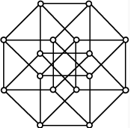4D Conceptual Work
Move a cube perpendicularly to itself, and a tesseract will emerge from it
The cube is representing space as we know it. A direction perpendicular to it is not familiar to us, and we have accepted this restriction until mathematician Bernhard Riemann presented a new view on geometry in 1854. He generalised Euclidian to Non-Euclidian geometry, enabling these reflections.
To experience hyperspace, we refer to analogy. Single elements of the dimensions [0D] up to [3D],
points - lines - planes - spaces,
are transported through line of evidence into hyperspace. So, a hyper cube called tesseract can be obtained from a cube. This way, we may enter hyperspace by means of imagination at least mentally.

A teseract is a 4-dimensional cube, or, to be more precisely, a hyper cube.
It has 16 angles, 32 edges, 24 squares, and is limited by eight 3-dimensional cubes.
This depiction is a parallel projection from hyperspace [4D] to space [3D] and projected from there on a plane [2D]. According to the chosen perspective, other perceptions are possible as well.
Training:
- Try to identify all 8 cubes [3D] in the depicture below.

Mathematicians may relax when looking at the following sequence of objects with 2 up to 7 degrees of freedom in movements

For the following, the meaning of "Folding"and "Unfolding" has to be introduced.
Unfolding of a cube

Unfolding a 3D cube and dismantling it into its parts results in a graticule consisting of 6 planes [2D].
This depicture is showing one out of 11 possible forms of graticules.
Such a graticule may serve as instruction for construction of a cube as well.
Folding of a cube
Here 5 out of 6 planes [2D] have to be folded (bent at their lines of contact) and thus to be moved through space [3D]!
Unfolding of a tesseract

When a tesseract [4D] is unfolded, 8 cubes [3D] are forming it.
The planes in the depiction (left), signified as a, b, c, d, e are laying on each other when folded.
Folding of a tesseract

We go ahead as we did for the cube

One out of 8 cubes forming the tesseract stays now in 3rd dimension.
The other 7 cubes [3D] of the tesseract are moved through hyperspace [4D] and folded
If your visitor from 4th dimension is busy just now, let him do this later.
To do the task ourselves, we have to do some training for the time being.
Tesseract from another perspective
 | In this view, we perceive a small cube inside a large one. Training:
|
Rotation of a Tesseract (a 2D projection of a 3D projection)
 | The eye is marvelled, and the mind is wondering
|
giving it more "flesh on the abstract bones"
This is only one of the possible cycles.
Very often, the others are coming in-between.
This is one of the phenomena of curved space, for this is what we are dealing with in 4th dimension.
The comprehensible results:
During time lapse of a tesseract's rotation
- inside becomes outside
- top becomes bottom
- front becomes behind
- right becomes left
and vice versa....
There is a lot to think.
- It is interesting to state that from hyperspace every space taking object (body) can be looked inside and intervened, which is, seen from our side, potentially supernatural.

Mathematician's are joking that everything should be in pairs when going on hyperspace trip, for it is uncertain in which condition one is leaving it again. Worst case is to get out totally introverted.
Mathworld.wolfram.com links to explore:
Spirtual View
From this conceptual view of hyperspace, the 4th dimension seems to have some qualities to make a higher reality (one above our 3D) a little more understandable, regarding
-
- omniscience (all-knowing)
and - omnipotence (all-powerful)
- omniscience (all-knowing)
see chapter Dimensional Views [ 01.01 ] Eye In The Hand
and more to comeIt seems
- we cannot expect to enter this 4th dimension with our bodies - without a permanent change in orientation.
- our mind is not able to understand a perpendicular move to space (3D) intuitively.
- higher spiritual qualities may belong to the nature of 4D.
Zero Dimension [0D]
Zero dimension represents a state of zero degrees of freedom in movements.
It seems to be optimal for
- meditation (zero movements of body & mind) and total relaxation (kayotsarg).
Zero and 4th dimension have high spiritual qualities.
 Editor Aparigraha Jain
Editor Aparigraha Jain
 Editor Carla Geerdes
Editor Carla Geerdes

